Jaemin Cho
A Survey on Long-Video Storytelling Generation: Architectures, Consistency, and Cinematic Quality
Jul 09, 2025Abstract:Despite the significant progress that has been made in video generative models, existing state-of-the-art methods can only produce videos lasting 5-16 seconds, often labeled "long-form videos". Furthermore, videos exceeding 16 seconds struggle to maintain consistent character appearances and scene layouts throughout the narrative. In particular, multi-subject long videos still fail to preserve character consistency and motion coherence. While some methods can generate videos up to 150 seconds long, they often suffer from frame redundancy and low temporal diversity. Recent work has attempted to produce long-form videos featuring multiple characters, narrative coherence, and high-fidelity detail. We comprehensively studied 32 papers on video generation to identify key architectural components and training strategies that consistently yield these qualities. We also construct a comprehensive novel taxonomy of existing methods and present comparative tables that categorize papers by their architectural designs and performance characteristics.
CLaMR: Contextualized Late-Interaction for Multimodal Content Retrieval
Jun 06, 2025Abstract:Online video web content is richly multimodal: a single video blends vision, speech, ambient audio, and on-screen text. Retrieval systems typically treat these modalities as independent retrieval sources, which can lead to noisy and subpar retrieval. We explore multimodal video content retrieval, where relevance can be scored from one particular modality or jointly across multiple modalities simultaneously. Consequently, an effective retriever must dynamically choose which modality (or set of modalities) best addresses the query. We introduce CLaMR, a multimodal, late-interaction retriever that jointly indexes 4 modalities: video frames, transcribed speech, on-screen text, and metadata. CLaMR jointly encodes all modalities with a unified multimodal backbone for improved contextualization and is trained to enhance dynamic modality selection via two key innovations. First, given the lack of training data for multimodal retrieval, we introduce MultiVENT 2.0++, a large-scale synthetic training dataset built on MultiVENT 2.0 (event-centric videos in various languages paired with queries) with modality-targeted queries. Next, we propose a modality-aware loss that jointly trains according to a standard contrastive objective alongside an objective for learning correct modality usage. On the test sets of MultiVENT 2.0++ and MSRVTT, conventional aggregation strategies, such as averaging similarities for baseline retrievers, degrade performance by introducing noise from irrelevant modalities. In contrast, CLaMR consistently outperforms existing retrievers: on MultiVENT 2.0++, CLaMR improves nDCG@10 by 25.6 over the best single-modality retriever and by 35.4 over the best multi-modality retriever. We illustrate CLaMR's downstream utility on long-video QA, retrieving relevant frames and obtaining a 3.50% boost over LanguageBind on Video-MME and 1.42% over dense sampling on LongVideoBench.
EPiC: Efficient Video Camera Control Learning with Precise Anchor-Video Guidance
May 28, 2025Abstract:Recent approaches on 3D camera control in video diffusion models (VDMs) often create anchor videos to guide diffusion models as a structured prior by rendering from estimated point clouds following annotated camera trajectories. However, errors inherent in point cloud estimation often lead to inaccurate anchor videos. Moreover, the requirement for extensive camera trajectory annotations further increases resource demands. To address these limitations, we introduce EPiC, an efficient and precise camera control learning framework that automatically constructs high-quality anchor videos without expensive camera trajectory annotations. Concretely, we create highly precise anchor videos for training by masking source videos based on first-frame visibility. This approach ensures high alignment, eliminates the need for camera trajectory annotations, and thus can be readily applied to any in-the-wild video to generate image-to-video (I2V) training pairs. Furthermore, we introduce Anchor-ControlNet, a lightweight conditioning module that integrates anchor video guidance in visible regions to pretrained VDMs, with less than 1% of backbone model parameters. By combining the proposed anchor video data and ControlNet module, EPiC achieves efficient training with substantially fewer parameters, training steps, and less data, without requiring modifications to the diffusion model backbone typically needed to mitigate rendering misalignments. Although being trained on masking-based anchor videos, our method generalizes robustly to anchor videos made with point clouds during inference, enabling precise 3D-informed camera control. EPiC achieves SOTA performance on RealEstate10K and MiraData for I2V camera control task, demonstrating precise and robust camera control ability both quantitatively and qualitatively. Notably, EPiC also exhibits strong zero-shot generalization to video-to-video scenarios.
CAPTURe: Evaluating Spatial Reasoning in Vision Language Models via Occluded Object Counting
Apr 21, 2025Abstract:Recognizing and reasoning about occluded (partially or fully hidden) objects is vital to understanding visual scenes, as occlusions frequently occur in real-world environments and act as obstacles for spatial comprehension. To test models' ability to reason about multiple occluded objects, we introduce a novel task, Counting Amodally for Patterns Through Unseen REgions (CAPTURe), which requires a model to count objects arranged in a pattern by inferring how the pattern continues behind an occluder (an object which blocks parts of the scene). CAPTURe requires both recognizing visual patterns and reasoning, making it a useful testbed for evaluating vision-language models (VLMs) on whether they understand occluded patterns and possess spatial understanding skills. By requiring models to reason about occluded objects, CAPTURe also tests VLMs' ability to form world models that would allow them to fill in missing information. CAPTURe consists of two parts: (1) CAPTURe-real, with manually filtered images of real objects in patterns and (2) CAPTURe-synthetic, a controlled diagnostic with generated patterned images. We evaluate four strong VLMs (GPT-4o, Intern-VL2, Molmo, and Qwen2-VL) on CAPTURe, finding that models struggle to count on both occluded and unoccluded patterns. Crucially, we find that models perform worse with occlusion, suggesting that VLMs are also deficient in inferring unseen spatial relationships: even the strongest VLMs like GPT-4o fail to count with occlusion. In contrast, we find that humans achieve very little error on CAPTURe. We also find that providing auxiliary information of occluded object locations increases performance, underscoring that the model error comes both from an inability to handle occlusion as well as difficulty counting in images.
Executable Functional Abstractions: Inferring Generative Programs for Advanced Math Problems
Apr 14, 2025Abstract:Scientists often infer abstract procedures from specific instances of problems and use the abstractions to generate new, related instances. For example, programs encoding the formal rules and properties of a system have been useful in fields ranging from RL (procedural environments) to physics (simulation engines). These programs can be seen as functions which execute to different outputs based on their parameterizations (e.g., gridworld configuration or initial physical conditions). We introduce the term EFA (Executable Functional Abstraction) to denote such programs for math problems. EFA-like constructs have been shown to be useful for math reasoning as problem generators for stress-testing models. However, prior work has been limited to abstractions for grade-school math (whose simple rules are easy to encode in programs), while generating EFAs for advanced math has thus far required human engineering. We explore the automatic construction of EFAs for advanced math problems. We operationalize the task of automatically constructing EFAs as a program synthesis task, and develop EFAGen, which conditions an LLM on a seed math problem and its step-by-step solution to generate candidate EFA programs that are faithful to the generalized problem and solution class underlying the seed problem. Furthermore, we formalize properties any valid EFA must possess in terms of executable unit tests, and show how the tests can be used as verifiable rewards to train LLMs to become better writers of EFAs. We demonstrate that EFAs constructed by EFAGen behave rationally by remaining faithful to seed problems, produce learnable problem variations, and that EFAGen can infer EFAs across multiple diverse sources of competition-level math problems. Finally, we show downstream uses of model-written EFAs e.g. finding problem variations that are harder or easier for a learner to solve, as well as data generation.
Training-free Guidance in Text-to-Video Generation via Multimodal Planning and Structured Noise Initialization
Apr 11, 2025Abstract:Recent advancements in text-to-video (T2V) diffusion models have significantly enhanced the visual quality of the generated videos. However, even recent T2V models find it challenging to follow text descriptions accurately, especially when the prompt requires accurate control of spatial layouts or object trajectories. A recent line of research uses layout guidance for T2V models that require fine-tuning or iterative manipulation of the attention map during inference time. This significantly increases the memory requirement, making it difficult to adopt a large T2V model as a backbone. To address this, we introduce Video-MSG, a training-free Guidance method for T2V generation based on Multimodal planning and Structured noise initialization. Video-MSG consists of three steps, where in the first two steps, Video-MSG creates Video Sketch, a fine-grained spatio-temporal plan for the final video, specifying background, foreground, and object trajectories, in the form of draft video frames. In the last step, Video-MSG guides a downstream T2V diffusion model with Video Sketch through noise inversion and denoising. Notably, Video-MSG does not need fine-tuning or attention manipulation with additional memory during inference time, making it easier to adopt large T2V models. Video-MSG demonstrates its effectiveness in enhancing text alignment with multiple T2V backbones (VideoCrafter2 and CogVideoX-5B) on popular T2V generation benchmarks (T2VCompBench and VBench). We provide comprehensive ablation studies about noise inversion ratio, different background generators, background object detection, and foreground object segmentation.
Polarimetric BSSRDF Acquisition of Dynamic Faces
Dec 29, 2024
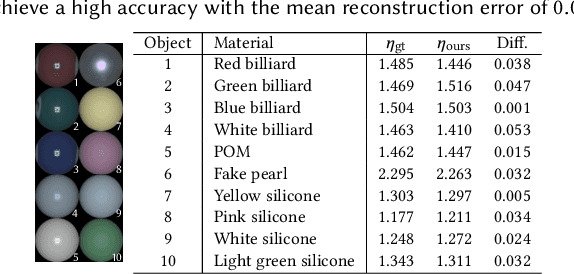
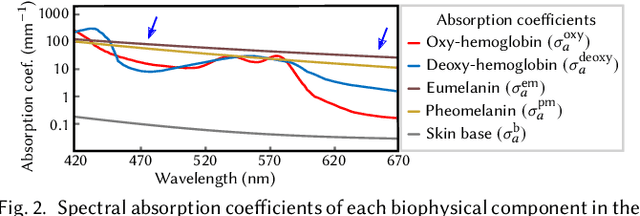

Abstract:Acquisition and modeling of polarized light reflection and scattering help reveal the shape, structure, and physical characteristics of an object, which is increasingly important in computer graphics. However, current polarimetric acquisition systems are limited to static and opaque objects. Human faces, on the other hand, present a particularly difficult challenge, given their complex structure and reflectance properties, the strong presence of spatially-varying subsurface scattering, and their dynamic nature. We present a new polarimetric acquisition method for dynamic human faces, which focuses on capturing spatially varying appearance and precise geometry, across a wide spectrum of skin tones and facial expressions. It includes both single and heterogeneous subsurface scattering, index of refraction, and specular roughness and intensity, among other parameters, while revealing biophysically-based components such as inner- and outer-layer hemoglobin, eumelanin and pheomelanin. Our method leverages such components' unique multispectral absorption profiles to quantify their concentrations, which in turn inform our model about the complex interactions occurring within the skin layers. To our knowledge, our work is the first to simultaneously acquire polarimetric and spectral reflectance information alongside biophysically-based skin parameters and geometry of dynamic human faces. Moreover, our polarimetric skin model integrates seamlessly into various rendering pipelines.
VideoRepair: Improving Text-to-Video Generation via Misalignment Evaluation and Localized Refinement
Nov 22, 2024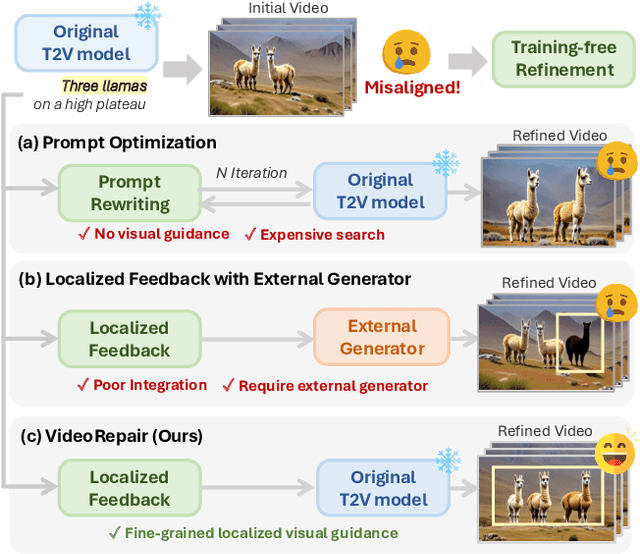
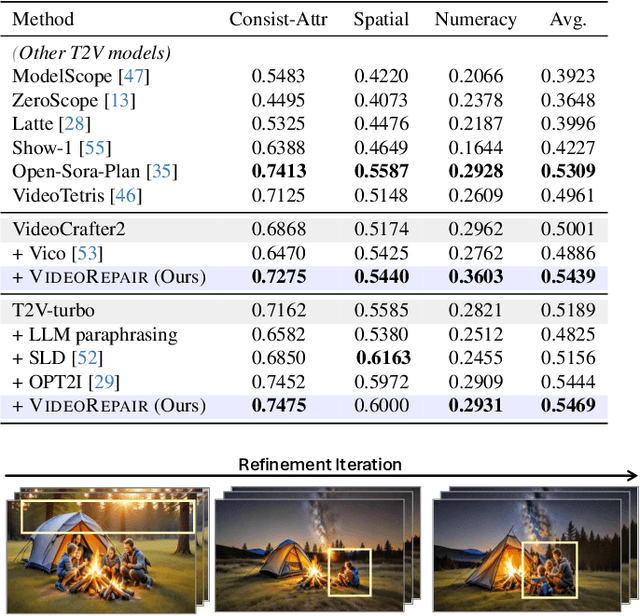
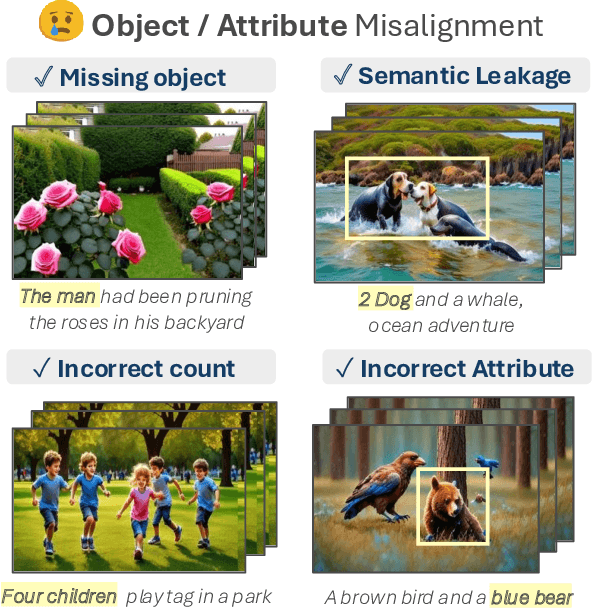

Abstract:Recent text-to-video (T2V) diffusion models have demonstrated impressive generation capabilities across various domains. However, these models often generate videos that have misalignments with text prompts, especially when the prompts describe complex scenes with multiple objects and attributes. To address this, we introduce VideoRepair, a novel model-agnostic, training-free video refinement framework that automatically identifies fine-grained text-video misalignments and generates explicit spatial and textual feedback, enabling a T2V diffusion model to perform targeted, localized refinements. VideoRepair consists of four stages: In (1) video evaluation, we detect misalignments by generating fine-grained evaluation questions and answering those questions with MLLM. In (2) refinement planning, we identify accurately generated objects and then create localized prompts to refine other areas in the video. Next, in (3) region decomposition, we segment the correctly generated area using a combined grounding module. We regenerate the video by adjusting the misaligned regions while preserving the correct regions in (4) localized refinement. On two popular video generation benchmarks (EvalCrafter and T2V-CompBench), VideoRepair substantially outperforms recent baselines across various text-video alignment metrics. We provide a comprehensive analysis of VideoRepair components and qualitative examples.
M3DocRAG: Multi-modal Retrieval is What You Need for Multi-page Multi-document Understanding
Nov 07, 2024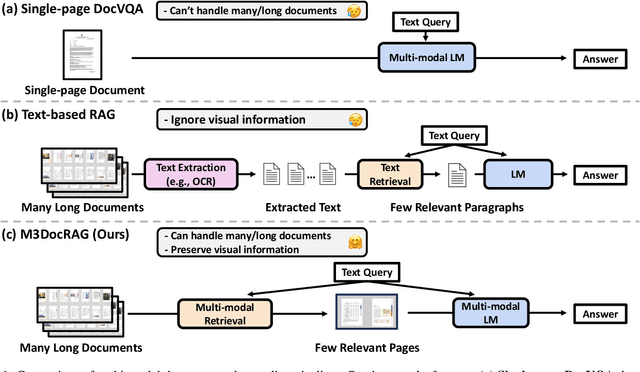


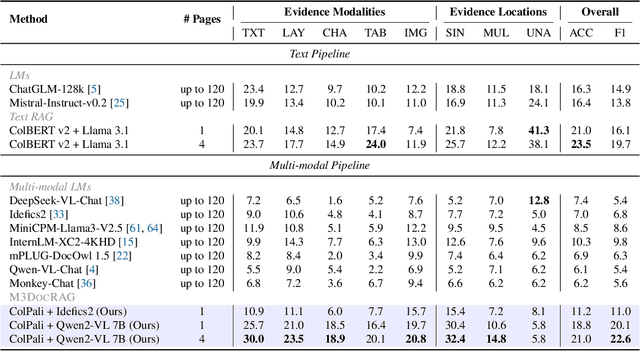
Abstract:Document visual question answering (DocVQA) pipelines that answer questions from documents have broad applications. Existing methods focus on handling single-page documents with multi-modal language models (MLMs), or rely on text-based retrieval-augmented generation (RAG) that uses text extraction tools such as optical character recognition (OCR). However, there are difficulties in applying these methods in real-world scenarios: (a) questions often require information across different pages or documents, where MLMs cannot handle many long documents; (b) documents often have important information in visual elements such as figures, but text extraction tools ignore them. We introduce M3DocRAG, a novel multi-modal RAG framework that flexibly accommodates various document contexts (closed-domain and open-domain), question hops (single-hop and multi-hop), and evidence modalities (text, chart, figure, etc.). M3DocRAG finds relevant documents and answers questions using a multi-modal retriever and an MLM, so that it can efficiently handle single or many documents while preserving visual information. Since previous DocVQA datasets ask questions in the context of a specific document, we also present M3DocVQA, a new benchmark for evaluating open-domain DocVQA over 3,000+ PDF documents with 40,000+ pages. In three benchmarks (M3DocVQA/MMLongBench-Doc/MP-DocVQA), empirical results show that M3DocRAG with ColPali and Qwen2-VL 7B achieves superior performance than many strong baselines, including state-of-the-art performance in MP-DocVQA. We provide comprehensive analyses of different indexing, MLMs, and retrieval models. Lastly, we qualitatively show that M3DocRAG can successfully handle various scenarios, such as when relevant information exists across multiple pages and when answer evidence only exists in images.
DataEnvGym: Data Generation Agents in Teacher Environments with Student Feedback
Oct 08, 2024Abstract:The process of creating training data to teach models is currently driven by humans, who manually analyze model weaknesses and plan how to create data that improves a student model. Recent approaches using LLMs as annotators reduce human effort, but still require humans to interpret feedback from evaluations and control the LLM to produce data the student needs. Automating this labor-intensive process by creating autonomous data generation agents - or teachers - is desirable, but requires environments that can simulate the feedback-driven, iterative, closed loop of data creation. To enable rapid and scalable testing for such agents and their modules, we introduce DataEnvGym, a testbed of teacher environments for data generation agents. DataEnvGym frames data generation as a sequential decision-making task, involving an agent consisting of a data generation policy (which generates a plan for creating training data) and a data generation engine (which transforms the plan into data), inside an environment that provides student feedback. The agent's goal is to improve student performance. Students are iteratively trained and evaluated on generated data, with their feedback (in the form of errors or weak skills) being reported to the agent after each iteration. DataEnvGym includes multiple teacher environment instantiations across 3 levels of structure in the state representation and action space. More structured environments are based on inferred skills and offer more interpretability and curriculum control. We support 3 diverse tasks (math, code, and VQA) and test multiple students and teachers. Example agents in our teaching environments can iteratively improve students across tasks and settings. Moreover, we show that environments teach different skill levels and test variants of key modules, pointing to future work in improving data generation agents, engines, and feedback mechanisms.
 Add to Chrome
Add to Chrome Add to Firefox
Add to Firefox Add to Edge
Add to Edge